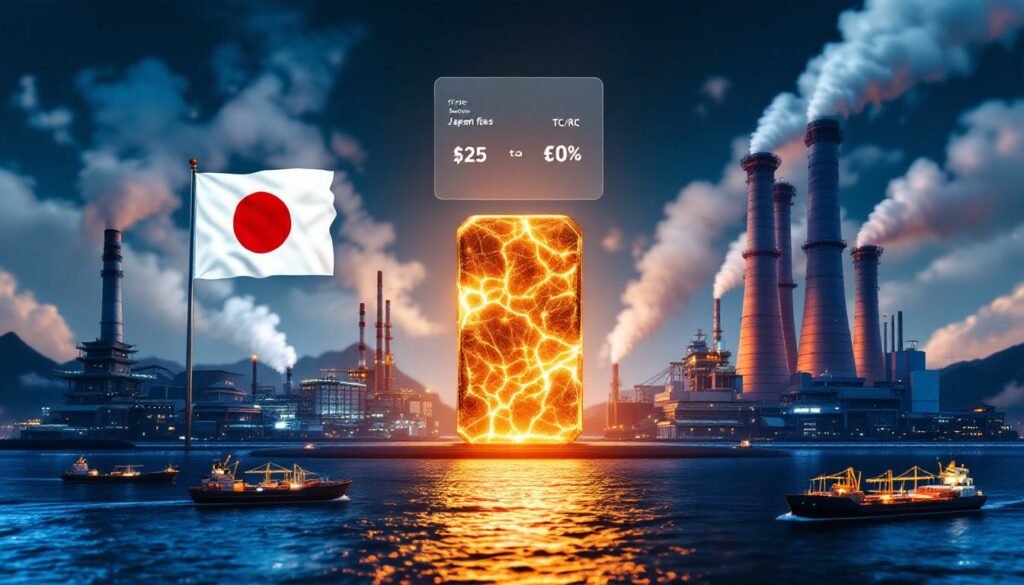Understanding Japan's Copper Smelter Negotiations: A Global Industry Perspective
The global copper industry is witnessing an unprecedented shift in power dynamics as Japanese copper smelters find themselves in increasingly difficult negotiations with international mining companies. At the heart of this tension lies a complex web of economic pressures, competitive disadvantages, and critical minerals security concerns that extend far beyond simple business negotiations. The situation highlights the growing influence of Chinese smelting operations and raises important questions about the future structure of global copper supply.
As these negotiations unfold, industry experts are closely monitoring how Japanese smelters navigate these challenges, with potential implications for copper price trends and international trade relations. The outcomes could reshape the copper processing landscape for years to come.
What Are TC/RCs and Why Do They Matter in Copper Processing?
The Fundamentals of Treatment Charges and Refining Charges
Treatment charges (TC) and refining charges (RC) represent the fees miners pay to smelters for processing copper concentrate into refined metal. These charges function as the primary revenue stream for smelting operations worldwide and establish the economic foundation of the copper processing industry. Typically expressed as dollars per metric ton for treatment charges and cents per pound for refining charges, these fees compensate smelters for the complex, energy-intensive work of extracting pure copper from ore concentrates.
The processing journey involves multiple technical stages: the concentrate first undergoes smelting at high temperatures to remove impurities, followed by electrolytic refining to achieve the 99.99% purity required for commercial applications. Each step requires significant capital investment, specialized expertise, and substantial operational expenditure—all factors reflected in the TC/RC structure.
How TC/RCs Reflect Market Conditions
TC/RCs serve as a critical barometer of copper market conditions, fluctuating based on the delicate balance between concentrate supply and global smelting capacity. When copper concentrate is abundant relative to available processing capacity, smelters can command higher TC/RCs, boosting their profit margins. Conversely, when concentrate becomes scarce or smelting capacity expands too rapidly, processing facilities must compete for material by accepting lower fees.
This dynamic creates a counter-cyclical relationship between miners and smelters. During periods of high copper production, miners face lower profitability while smelters benefit from higher TC/RCs. When mining output contracts, the reverse occurs—highlighting the interconnected yet sometimes adversarial nature of the copper supply chain.
Why Are Japanese Smelters Facing Difficult Negotiations in 2025?
The Unprecedented Zero-Fee Precedent
The copper processing industry faced a seismic shift in June 2025 when certain Chinese smelters agreed to process copper concentrate for Chilean mining giant Antofagasta at the unprecedented rate of $0 per metric ton and 0 cents per pound. This zero-fee arrangement represents a staggering departure from established industry norms and creates immense pressure on smelters globally.
According to Reuters reporting (June 20, 2025), this dramatic reduction compares to the 2025 annual benchmark of $21.25 per ton and 2.125 cents per pound that had been established earlier between Chinese smelters and the same miner. The zero-fee precedent effectively eliminates the traditional revenue model for copper processing and forces smelters worldwide to reconsider their business strategies.
Japan's Higher Cost Structure
Japanese smelters secured significantly higher TC/RCs of $25 per ton and 2.5 cents per pound for 2025 in negotiations concluded around May—a rate that reflected their higher operational costs compared to Chinese counterparts. These higher processing fees were considered necessary for Japanese operations to maintain profitability given their distinct cost structures.
Japanese copper processing facilities typically operate under stricter environmental regulations, higher labor costs, and more expensive energy inputs than many Chinese operations. Additionally, Chinese smelters often benefit from economies of scale, vertical integration advantages, and various forms of government support that enable them to process copper concentrate at lower margins.
Competitive Disadvantage Concerns
JMIA Chairman Tetsuya Tanaka, who also serves as president of Mitsubishi Materials, has explicitly stated that Japanese smelters simply cannot accept the terms agreed to by Chinese smelters. As reported by Reuters, Tanaka warned that "miners have proposed charges even lower than the 2025 annual levels" in mid-year negotiations, further exacerbating the competitive pressure.
This widening gap in processing fees creates a significant competitive disadvantage for Japanese operations, threatening their long-term viability. The situation has become so dire that Tanaka believes "negotiations by the private sector alone cannot easily break the deadlock," suggesting the need for government intervention—an unusual step that underscores the severity of the situation.
How Does China's Smelting Industry Influence Global Processing Fees?
China's Dominant Market Position
China has established itself as the world's largest copper processing hub, giving Chinese smelters unprecedented influence over global TC/RC negotiations. Their willingness to accept extremely low or even zero processing fees—as demonstrated in the June 2025 agreement with Antofagasta—creates ripple effects throughout the industry and puts immense pressure on non-Chinese smelters.
The ability of Chinese operators to set de facto benchmarks for processing fees stems from their massive processing capacity and their position as the primary destination for copper concentrate. This market dominance allows Chinese smelters to dictate terms that other regions struggle to match, creating a competitive imbalance that threatens the diversity of global copper processing.
Expansion of Chinese Smelting Capacity
China's aggressive expansion of smelting capacity has fundamentally altered the supply-demand dynamics of copper processing. While specific capacity figures weren't disclosed in the source material, industry analysts have long observed China's strategic investment in expanding its copper processing infrastructure to support its manufacturing sector.
This rapid capacity growth creates a situation where Chinese smelters can accept lower processing fees while maintaining profitability through various mechanisms: scale economies, vertical integration benefits, byproduct recovery advantages, or government policies that support strategic industries. The resulting competitive landscape puts immense pressure on operations in countries like Japan that lack similar advantages.
Impact on Global Smelting Economics
The terms accepted by Chinese smelters increasingly function as de facto benchmarks for the industry, creating challenges for higher-cost operations worldwide. According to Tanaka, these terms are "unacceptable for [Japanese] firms," highlighting the growing economic divergence between Chinese and non-Chinese processing operations.
This divergence threatens to create a two-tier market in which Chinese smelters operate under one economic model while smelters in Japan, Europe, and elsewhere must find alternative approaches to remain viable. The long-term implications could include consolidation of global smelting capacity in China, reducing diversity in the copper supply chain and potentially increasing vulnerability to supply disruptions.
What Strategies Are Japanese Smelters Employing?
Government Intervention Requests
In a significant escalation beyond typical commercial negotiations, JMIA Chairman Tanaka has formally appealed to the Japanese government for support. As reported in industry publications dated July 24, 2025, Tanaka stated that "negotiations by the private sector alone cannot easily break the deadlock," indicating the extraordinary nature of the current situation.
This request for government intervention represents a recognition that market forces alone may not resolve the competitive imbalance. While specific support measures have not been disclosed, options could potentially include trade policy adjustments, financial assistance programs, or diplomatic engagement with copper-producing nations to ensure fair treatment of Japanese processing facilities.
Potential International Coordination
Tanaka has suggested a coordinated international response, specifically "asking the Japanese government to act in unison… [with] possible collaboration with other non-Chinese consumer countries." This approach acknowledges that the challenges facing Japanese smelters extend to operations in other developed economies and may require a multilateral solution.
Such international coordination could potentially involve countries with significant copper smelting operations like South Korea, Germany, Spain, and Chile—all of which face similar competitive pressures from Chinese operations. By aligning their approaches, these nations might gain greater leverage in negotiations with mining companies and promote more sustainable processing fee structures.
Maintaining Higher Processing Fees
Japanese smelters are engaged in difficult negotiations to preserve processing fees that reflect their actual operational costs, resisting the downward pressure created by Chinese zero-fee arrangements. Their goal appears to be maintaining TC/RCs closer to the $25 per ton and 2.5 cents per pound secured earlier in 2025, rather than accepting the dramatic reductions proposed in mid-year talks.
This strategy requires convincing miners of the value proposition offered by Japanese smelters—potentially including factors like processing reliability, product quality, technical expertise, and strategic supply chain diversification. The challenge lies in quantifying these benefits in ways that justify higher processing fees in an increasingly competitive global market.
What Are the Broader Implications for Global Copper Supply?
Threat to Non-Chinese Smelting Operations
Tanaka has explicitly warned that "shrinking smelting margins are placing non-Chinese smelters under severe pressure," highlighting the existential threat faced by copper processing operations outside China. This pressure could potentially lead to capacity reductions, facility closures, or industry consolidation in countries like Japan that cannot match Chinese processing economics.
The potential loss of smelting capacity outside China raises significant concerns about the resilience and diversity of global copper supply chains. Concentration of processing capabilities in a single country creates vulnerability to disruptions from natural disasters, policy changes, labor disputes, or trade war impacts —all risks that diversified supply chains help mitigate.
Supply Chain Resilience Concerns
The potential consolidation of smelting capacity in China raises profound questions about supply chain resilience, particularly for countries like Japan that rely on domestic processing capabilities to support strategic industries such as electronics, automotive manufacturing, and renewable energy technologies.
While not explicitly stated in the source material, the Japanese government's interest in maintaining domestic smelting capabilities likely stems from recognition of copper's critical role in these industries. Excessive dependence on Chinese processing would create vulnerability to supply disruptions or pricing pressures that could impact Japan's industrial competitiveness.
Price Impacts for End Users
The compression of TC/RCs may eventually lead to higher refined copper prices if it results in the closure of smelting operations outside China. Reduced competition in the processing segment could give remaining smelters greater pricing power over time, potentially increasing costs for downstream manufacturers in sectors ranging from construction to electronics.
This dynamic illustrates the complex balance between short-term and long-term interests in the copper supply chain. While miners benefit from lower processing fees in the near term, the resulting industry consolidation could ultimately lead to higher overall costs and reduced optionality for all participants in the copper value chain.
How Does This Relate to Critical Minerals Security?
Japan's Strategic Minerals Approach
According to a Japanese Industry Ministry official cited in industry publications, the government "aims to maintain and strengthen domestic smelting of key minerals," recognizing the strategic importance of processing capabilities. While specific support measures for copper smelters have not been disclosed, this policy direction indicates recognition of copper's importance to national industrial security.
Japan's approach reflects growing global awareness of critical minerals supply chains as strategic assets rather than purely commercial operations. As countries worldwide reassess their industrial policies in light of recent supply chain disruptions, maintaining domestic processing capabilities for essential minerals like copper has gained increased policy attention.
Expanding National Stockpiles
Japan is actively working to bolster its national stockpiles of critical minerals by "increasing volumes or expanding target items," though specific details remain confidential for national security reasons. This stockpiling strategy represents a concrete step toward reducing vulnerability to supply disruptions and price volatility.
The inclusion of copper in these stockpiling efforts would be consistent with its status as an essential industrial metal, though the source material does not explicitly confirm whether copper is among the targeted minerals. Regardless, the broader stockpiling initiative demonstrates Japan's commitment to securing reliable access to critical raw materials.
Parallel Challenges with Other Metals
The challenges facing copper processors exist within a broader context of critical minerals security concerns. As noted in industry publications, Mitsubishi Materials is currently experiencing "tight and insufficient" supplies of tungsten following China's export restrictions on rare metals, highlighting the interconnected nature of these issues.
This parallel situation with tungsten illustrates how concentration of processing or production in a single country can create vulnerability to policy changes or trade restrictions. The experience with tungsten may be influencing Japanese government and industry approaches to copper smelting, reinforcing the strategic importance of maintaining diverse supply sources and processing capabilities.
What Are the Potential Outcomes of These Negotiations?
Possible Scenarios for Japanese Smelters
While the source material doesn't outline specific scenarios, several potential outcomes appear possible based on the current situation:
-
Partial Fee Acceptance: Japanese smelters might negotiate TC/RCs significantly lower than their current $25/$0.025 rates but still above zero, finding a compromise position that reflects their cost structures.
-
Government Support Implementation: The Japanese government could introduce measures to support domestic smelting operations, potentially including energy subsidies, tax incentives, or requirements for domestic processing of copper used in government-funded projects.
-
Industry Restructuring: Japanese copper processors might pursue consolidation, operational efficiencies, or strategic partnerships to improve their cost competitiveness against Chinese operations.
-
Business Model Innovation: Smelters could develop alternative revenue streams less dependent on TC/RC income, such as enhanced recovery of precious metals, production of specialized copper products, or integration with downstream manufacturing.
Long-term Industry Structure Implications
The outcome of these negotiations could accelerate structural changes in the global copper processing industry. If non-Chinese smelters cannot find sustainable economic models, processing capacity may increasingly concentrate in China, creating a more centralized global supply chain with fewer alternative options.
Alternatively, recognition of the strategic importance of copper processing could lead to government interventions that maintain geographic diversity in smelting operations, potentially through coordinated policies among copper-consuming nations. The resulting industry structure would likely involve a complex balance between market forces and strategic considerations.
Impact on Future Contract Structures
The unprecedented zero-fee agreements could prompt a fundamental rethinking of how copper processing contracts are structured. Traditional TC/RC models may evolve toward more complex arrangements that include considerations beyond simple processing fees—potentially incorporating risk-sharing mechanisms, strategic partnership elements, or recognition of supply chain resilience value.
Such evolution would represent a significant shift in industry practice but might better reflect the economic realities of different regional operations and the strategic importance of maintaining diverse processing capabilities in the global copper supply chain.
FAQ: Understanding Copper Processing Economics
How do smelters make money if TC/RCs reach zero?
Smelters accepting zero TC/RCs must rely on alternative revenue streams to remain viable. These may include:
- Precious metal recovery: Extracting gold, silver, and other valuable metals present in copper concentrate
- Sulfuric acid production: Selling sulfuric acid generated during the smelting process
- Vertical integration benefits: Capturing value from downstream copper fabrication or upstream mining operations
- Strategic positioning: Temporarily accepting losses to maintain market share or fulfill strategic objectives
- Government support: Direct or indirect subsidies that reduce operational costs or provide other financial benefits
The viability of these alternative approaches varies significantly between operations and regions, explaining why Japanese smelters cannot match the zero-fee terms accepted by some Chinese counterparts.
Why can't Japanese smelters match Chinese TC/RC levels?
Japanese smelters face several structural disadvantages that prevent them from matching the extremely low TC/RCs accepted by some Chinese operations:
- Higher labor costs: Japan's labor market commands significantly higher wages than China
- Stricter environmental regulations: Japanese environmental standards typically require more extensive pollution control investments
- Higher energy prices: Japan's energy costs remain substantially higher than many Chinese regions
- Scale disadvantages: Many Japanese operations lack the massive scale of newer Chinese smelters
- Limited government support: Japanese smelters may receive less direct and indirect government assistance than strategic Chinese industries
These factors create a fundamentally different cost structure that makes zero-fee processing economically unviable for Japanese operations, as explicitly stated by JMIA Chairman Tanaka.
What role does government policy play in smelting competitiveness?
Government policies substantially impact smelting economics through multiple channels:
- Energy policy: Electricity typically represents 20-30% of smelting costs, making government energy policies crucial to competitiveness
- Environmental regulations: Emissions standards and waste management requirements significantly affect capital and operating expenses
- Labor laws: Workplace regulations, minimum wages, and social insurance requirements influence labor costs
- Strategic industry support: Direct subsidies, tax incentives, or preferential financing can provide competitive advantages
- Trade policies: Import/export regulations, tariffs, and quotas shape access to concentrate and refined copper markets
The divergence in these policies between countries contributes to the competitive disparities between Japanese and Chinese smelters, creating challenges that pure market forces cannot easily resolve.
How might these negotiations affect copper miners?
Lower TC/RCs benefit miners in the short term by reducing their processing costs and increasing their share of copper's value. However, several potential longer-term impacts merit consideration:
- Processing capacity concerns: If smelters outside China close due to economic pressure, miners may face reduced competition for their concentrate
- Geographic concentration risk: Excessive reliance on Chinese processing could create vulnerability to policy changes or trade disputes
- Quality considerations: Different smelters may offer varying capabilities for handling specific concentrate characteristics
- Strategic relationships: Miners with long-term supply relationships may need to balance immediate fee benefits against partnership value
- Market signal distortion: Zero TC/RCs may not accurately reflect sustainable processing economics, potentially leading to market distortions
Miners thus face complex strategic considerations beyond simply pursuing the
Ready to Spot the Next Major Mineral Discovery?
Gain instant notifications on significant ASX mineral discoveries through Discovery Alert's proprietary Discovery IQ model, transforming complex data into actionable investment insights. Understand why major discoveries can lead to exceptional returns by exploring Discovery Alert's dedicated discoveries page and begin your 30-day free trial today.




